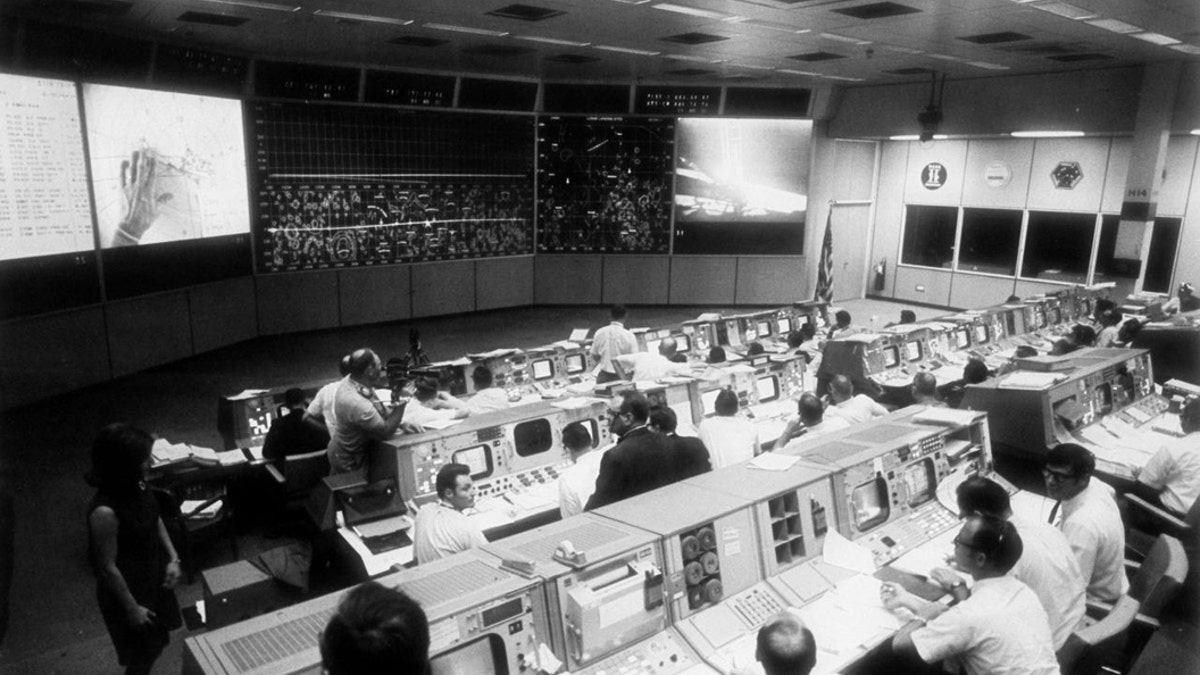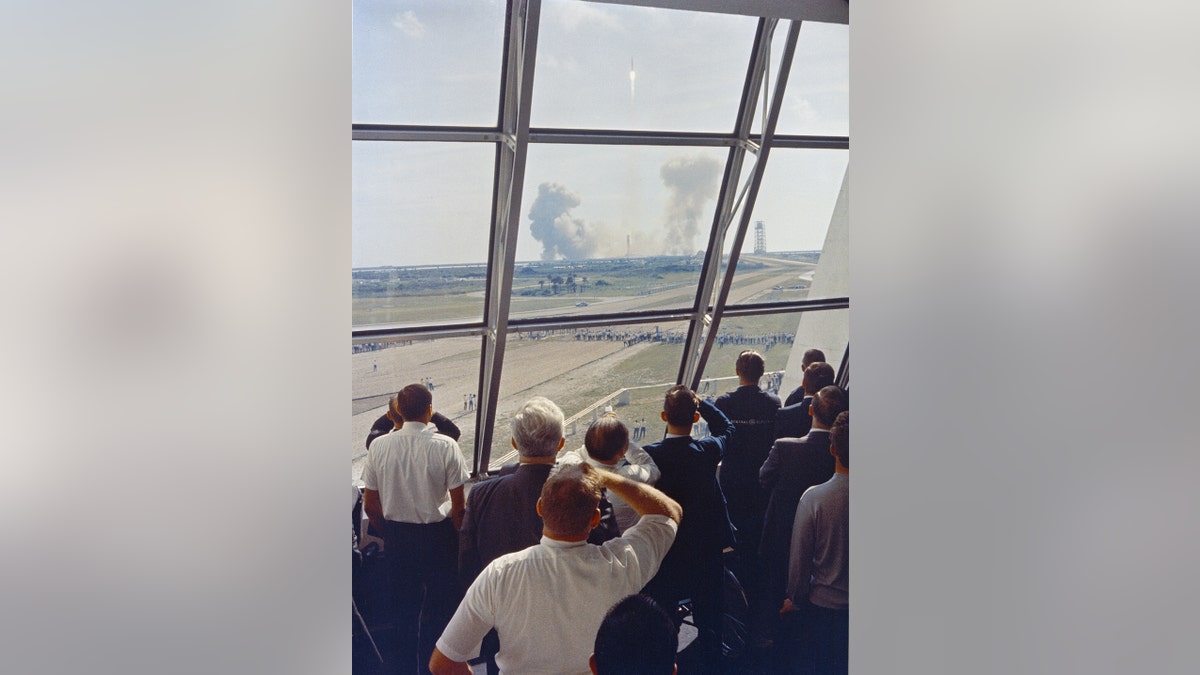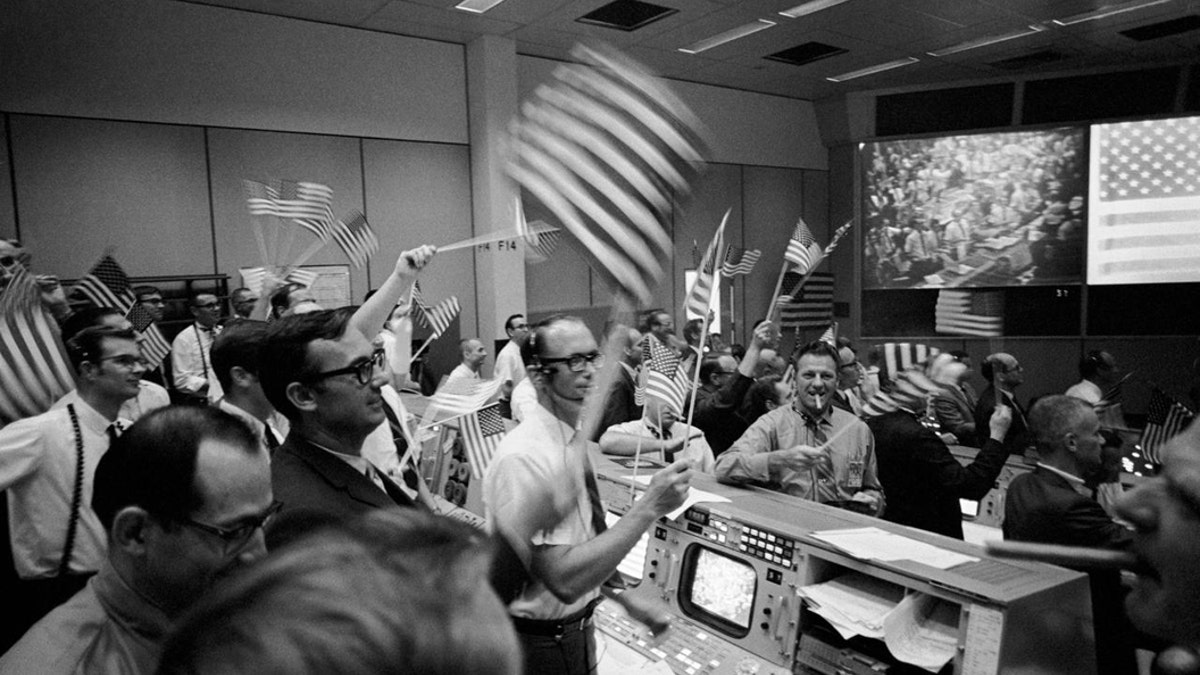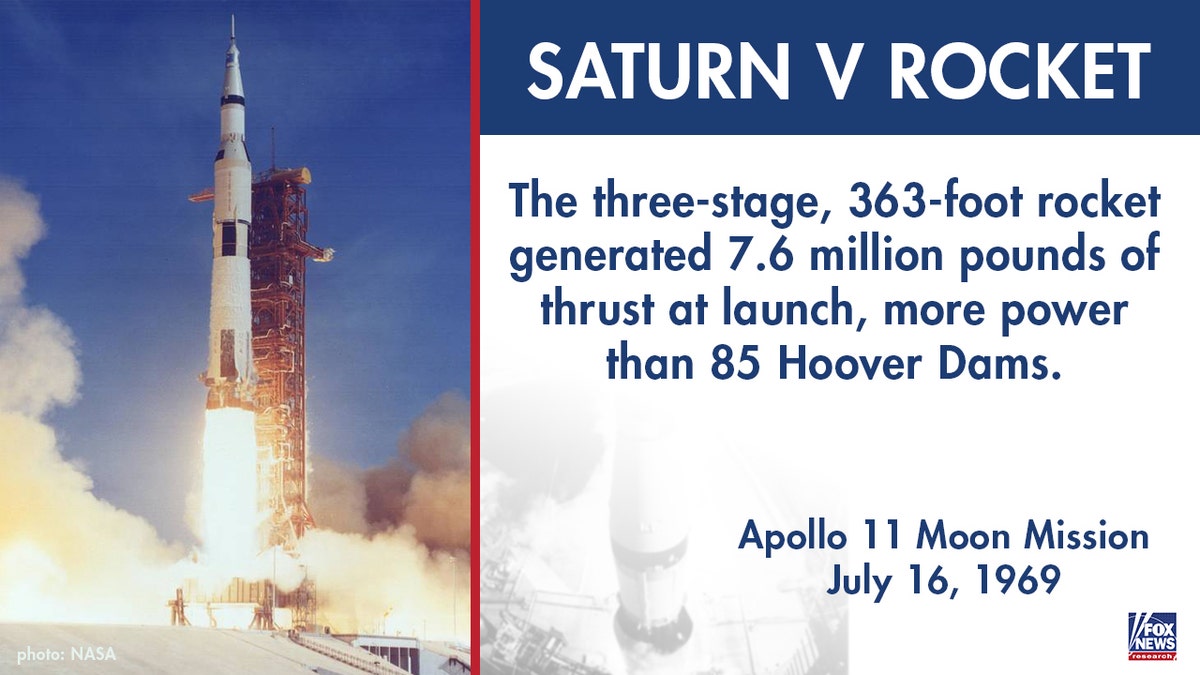Apollo 11 Moon landing: A brief timeline from 1961 to 1969
Apollo 11 landed on the Moon on July 20, 1969. Here is a brief timeline of events that lead to the historic moment, from President Kennedy's call to action in 1961 to 'The Eagle has landed' in 1969.
400,000. 3. 1969. 151.
These digits may seem like a random number sequence, but for a select few people in this country's history, they mean everything.
More than 400,000 people worked tirelessly to put astronauts Neil Armstrong, Buzz Aldrin and Michael Collins into space on a hot Florida day for the most famous space exploration mission in history, Apollo 11. After touchdown on July 20, 1969, Armstrong would spend just slightly more than 151 minutes walking around on the Moon's surface, with Aldrin clocking in at 40 minutes less. For these men, July 16 was nothing short of extraordinary — and extraordinarily hectic.

Overall view of the Mission Operations Control Room in the Mission Control Center, bldg 30, during the lunar surface extravehicular activity (EVA) of Apollo 11 Astronauts Neil A. Armstrong and Edwin E. Aldrin Jr. (Credit: NASA)
APOLLO 11'S MICHAEL COLLINS REFLECTS ON HISTORIC MOON LANDING: 'WE WERE JUST REGULAR ASTRONAUTS'
"Mission control was talking to me 24 hours a day," Collins recalled in an interview with Fox News last month, before adding that July 20 was an even busier day. "The last task we had coming back from the Moon was reentering the atmosphere at a distance of 250,000 miles. The corridor we had to hit was 40 miles high, a tiny, tiny target. When we splattered into the ocean, we had to go through a whole other sequence. So [on both days], we were busy, busy, busy."
But for the 400,000-strong men and women who worked tirelessly behind the scenes to achieve those first lunar footsteps, this was years in the making.
Nearly seven years prior, on Sept. 12, 1962, President John F. Kennedy gave his famous speech to a large crowd at Rice Stadium in which he decreed: "We choose to go to the Moon in this decade and do the other things, not because they are easy, but because they are hard."
As a result, people from all walks of life (engineers, scientists, pilots, secretaries and more) and various parts of the country participated in making the Apollo 11 voyage a rousing success. However, it was chaotic up until the last few seconds of the journey, especially for those inside Mission Control on that fateful day.
"The tension in Mission Control was higher than in the spacecraft," said Charlie Duke, Apollo 16 astronaut and the capsule communicator (CAPCOM) for Apollo 11. "We had communication problems and we had a computer problem that really got everyone's attention. Fortunately, the problem was diagnosed and we continued down."
"The tension in Mission Control was higher than in the spacecraft. We had communication problems and we had a computer problem that really got everyone's attention. Fortunately, the problem was diagnosed and we continued down."
Duke added that as the craft got within 400 to 500 feet of the surface of the Moon, Armstrong said he could not land in the original area and wound up flying the ship horizontally, causing extra fuel to be used.
"There was definite tension in Mission Control," Duke, who was the 10th person to walk on the Moon, told Fox News. "I called to be on the ground in 30 seconds. And 13 seconds later, Buzz said 'contact' and the engines stopped. We knew they were close because they were kicking up dust."
Gerald Griffin, the Apollo flight director, said he was able to watch the launch because his team's shift had ended.
"The tension was felt by everyone in that room," Griffin said, adding that there were about 20 people in the room at the time.
As tension rose and the nation watched on as NASA prepared to launch Apollo 11, many credit Gene Kranz, who served as NASA's second chief flight director, for helping keep the focus on the mission and the proverbial prize.

Personnel within the Launch Control Center watch the Apollo 11 liftoff from Launch Complex 39A today at the start of the historic lunar landing mission. The LCC is located three and one-half miles from the launch pad. (Credit: NASA)
"A minute or two before the engine lit, Gene came on the loop that everyone had to listen to in Mission Control," Homer Ahr, an IBM programmer who worked on the Apollo missions, recently told Fox News. "In his demanding, commanding and very monotone voice, [Kranz] said, 'We have just locked the doors and we are locked in this room together. We will leave this room together when one of three things happen — we land, abort or crash.' After he said that, if you didn't know this was important before, you knew it then."
Ahr said NASA had given them July 15 off after they had been "training nonstop for months, working 16 to 20 hours a day," in an effort to let them decompress and "come in fresh on the 16th."
"Our job was to arrive at 5 a.m.," Ahr said. "We brought up the machines and checked out the software to do a dry run of the launch without involving the flight controllers. Later, we brought up the prime computer we used and before you knew it, it was liftoff. I typed in one of the first things that we entered into the computer, the time of liftoff 8:[32 a.m. EST]. I made a whole bunch of commands after that, but it was really sort of weird."
Ahr continued: "We had a job to do and we did it, learning to work under enormous pressure in a complex situation. It was tense and it was a great feeling after 12 minutes when the third stage of the Saturn V shut off. You just hoped you didn't screw up or crap your pants."
"We had a job to do and we did it, learning to work under enormous pressure in a complex situation. It was tense and it was a great feeling after 12 minutes when the third stage of the Saturn V shut off. You just hoped you didn't screw up or crap your pants."
The tension inside Mission Control was so thick it could be cut with a knife, and for those covering the event, the anxiety and stress were just as palpable.
Walter Cronkite may not have been inside the room that was jam-packed with white shirts, black ties and pocket protectors, but CBS' managing editor of news was almost as much a part of the launch as Armstrong, Aldrin and Collins were.
"When they landed with 17 seconds of fuel left, we were all listening to Mission Control," former CBS correspondent David Schoumacher, who reported live during the Moon landing, said in a recent interview. "No one was saying anything in the studio or control room. We were all sweating it out just like the astronauts."
"There was no script for when Neil said, 'The Eagle has landed.' The director was looking at 30 monitors looking at pictures that would work and saw Walter rubbing his hands with that goofy gesture," Schoumacher added. "He [Walter] wanted to pray and he knew he shouldn't and he couldn't think of anything to say. That's perfect. What the hell can you say to something like that?"
50 YEARS AFTER APOLLO 11, NEIL ARMSTRONG'S SONS DESCRIBE THE DAY THEIR DAD WALKED ON THE MOON
Steve Bales, who was Apollo 11's guidance officer, one of its most critical roles, noted that communications were "dropping in and out" and for about 2 minutes on the 20th, they lost communication completely.

Picture of Apollo 11 guidance officer Steve Bales. (Credit: NASA-Houston Public Affairs)
"The data comes back and I'm sitting there with one of my displays and comparing things like altitude and velocity and there's a problem," Bales told Fox News. "We were going faster than 23 feet per second and if we got to 35 feet/per second, we'd have to stop. We weren't sure why this was happening and it didn't change for about 3 minutes. But at about 5 minutes into the descent, the landing radar locked onto the surface and I was relieved."
But the issues were not over — not by a long shot.
"About 10 seconds later, we got a 1202 alarm," Bales added. "We were running about 15 seconds behind the crew and [former senior NASA executive] Jack Garmin said 'Steve, if it doesn't reoccur, it's a go.' I immediately said, 'Flight we're going to alarm.' Neil, who never says anything during the critical phase, says 'Houston, give me a reading on 1202.' And Charlie Duke, who may have saved the mission, doesn't wait and tells the crew to go on the alarm. It was telling us the computer had too much to do, sending hundreds of signals at a time and that's why we got the 1202 alarm."
From there, all seemed quiet, with Bales thinking that the mission was "home free" on the 20th as the Eagle lander got down to around 7,000 feet. But 8 minutes into a process that took approximately 12.5 minutes, NASA got another alarm.
"We're so close now that there's a chance they might not be able to land manually," Bales said. "Bob Carlton, who was 10 years older than me, said there was no fuel gauge on the vehicle, only a sensor that was getting low. When the light went on, there were 90 seconds of fuel left, so he [Carlton] started a stopwatch and the program is resting on a guy with a stopwatch. The ground [Charlie Duke[ called out 60 seconds and at the time, we saw the vehicle shooting out across the Moon and Neil was going over football-field-sized craters. Thirty seconds and then a few seconds later, we heard touchdown and then tranquility base. And that's when we had to get ready."

S69-40022 (24 July 1969) --- Overall view of the Mission Operations Control Room (MOCR) in the Mission Control Center (MCC), Building 30, Manned Spacecraft Center (MSC), showing the flight controllers celebrating the successful conclusion of the Apollo 11 lunar landing mission. (Credit: NASA)
'THERE WAS A BIT OF TENSION' ASTRONAUT DESCRIBES WATCHING MOON LANDING WITH BUZZ ALDRIN'S FAMILY
No one could fault anyone NASA for celebrating the monumental achievement with a sip of alcohol or two, but that was not the case — at least not until later.
"We had what we called a state of the state a few minutes after they landed to make sure they were OK on the surface," Griffin said. "We didn't celebrate at touchdown, there was too much left to do."

(Fox News)
But when the crew landed back on Earth, the room got pretty crazy — cigars were smoked, flags were waved," Griffin added, noting that they later went to a local bar and had a beer bust. "It was a crazy time."
Now 50 years later, America is preparing to return to the Moon by 2024, and eventually, to Mars.
For many of the men and women who worked on Apollo 11, it was a job, one that came with enormous responsibility and pressure. In the moment, it was difficult to comprehend what actually happened. "No one joined the astronaut core to be a hero," Duke said. "We stay focused on our jobs. It's humbling on one hand and very satisfying on the other, but I don't wear a badge that says 'hero.'"
It wasn't until later, in some cases a few minutes, and in others, much, much later, that the impact was felt.
"After our debriefing, I walked out to my car, stuck the keys into the ignition and I couldn't start the car," Ahr said. "That's when it hit me when I realized what we had done. I just sat there for five minutes and kept saying, 'We landed on the Moon.'"
Amidst all the chaos inside Mission Control, Griffin said there was one thing that stood out about this unmatched triumph of the human spirit: pride.
"Not just for the whole country, but the whole world."
CLICK HERE TO GET THE FOX NEWS APP
Be sure to catch the America’s News HQ Apollo 11 50th anniversary special on Fox News on Saturday, July 20 at 12 PM EST.





















